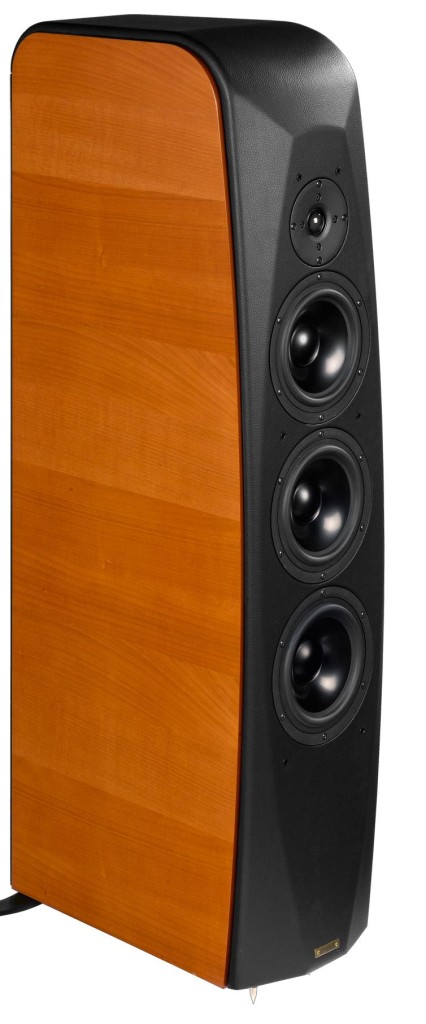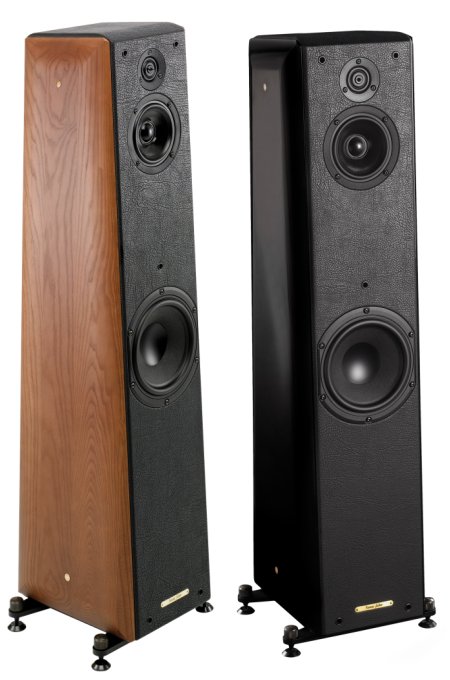The basics:
1 – Loudspeakers are to be placed along the same wall at a certain distance from it and the lateral walls (not in the corners!)
2 – The listening room will be furnished with sound absorbing materials (couches, armchairs, pillows, wooden furniture full of books, frames with no glass, curtains covering windows, carpet in front of loudspeakers)
3 – The tweeter will be at the same level as the listener’s ears (loudspeakers must be standing, not on their sides!)
4 – Between loudspeakers and listener there won’t be any obstacle to sound propagation; even better if the space between the loudspeaker is also empty.
This is the minimum! Otherwise it is useless you keep on reading…
The main responsible of the sound character of a HiFi system is the loudspeaker pair (=2 -> two). Therefore, it is better to put together a new system beginning from them: we choose the loudspeakers we like most or that better adapt to our situation, room, wallet, etc., than we match them to the best amplifier possible. If we already have a pair at home, we better understand ASAP whether it is good to keep them and build a system around them (or improve the existing one). Otherwise, better to sell them as long as we can and get something we like more. The loudspeakers will also concentrate most of the budget we want to invest. Such is the impact of the loudspeakers on the final quality of the system.
How are thay made
Loudspeakers are actually a system of loudspeakers units capable of reproducing a good portion of the frequencies the human ear can perceive. I said a good portion, since it is not easy to find systems that would be able to reproduce the lowest frequencies we can hear. The human ear is sensible to frequencies in the 20 to 20000 Hz range (Hertz = cycles per second). The ends of the range are not really audible by everybody. With age, we slowly lose the ability to hear certain frequencies, especially the higher ones. It is true that just a few recordings ever made contain 20-40 Hz signals (very few musical instruments are capable of reproducing them). To get really so low in frequency, a loudspeaker system must be very large, since its plinth has to resonate at the lower frequencies pertaining to the woofer.
The other units could also stay out of the plinth, but in general they are mounted on it, too. The simplest systems have just two units: a woofer and a tweeter. A crossover circuit filters the frequencies, distributing the medium-highs to the tweeter and the medium-lows to the woofer. Years ago it was common to find an additional unit for the mid frequencies, the midrange, but it would complicate the project and many designers abandoned the idea of 3-way systems, at least in the cheapest projects (not true for the excellent Italian-made Sonus Faber Domus Grand Piano in the above picture, with double woofer, bass reflex and midrange). While choosing the loudspeakers for our hypothetical first HiFi system, we better stay with 2-way projects, just for simplicity sake while we are moving the first steps.
Used loudspeakers: safe buy? Yes…
Loudspeaker systems are almost eternal if treated well. The used market offers a lot of bargains. Normally, modern loudspeaker systems are deeper than larger. This allows loading the woofer better and the limited baffle width minimizes interference with the emitted soundwaves. The speakers’ membrane may be damaged, creased by long term exposition to humidity or by time itself. The woofer cone must be intact and free of moving with no effort or strange noises. Using a finger will be enough for a check. If the dealer still markets the loudspeaker system or still offers maintenance, it might be worth replacing damaged loudspeaker units. Otherwise, there are professionals who are able to do the job easily and unexpensively. Speaking about brands, Italy based Indiana Line offer very good loudspeaker systems at affordable prices, even if you’re buying new. Other Italian brands worth mentioning are Opera Loudspeakers (Opera Quinta, below), Aliante and Chario
(you’ll be surprised to hear how good Italian speakers are).
Amplifier matching is critical here. Loudspeakers with a warm sound will match well to amplifiers with more detailed, clear sound. Matching amps and speakers with the same character may result in exaggeration. Better to put together units with opposite character in order to obtain a much balanced sound.
Loudspeaker systems have different impedance and sensitivity. A low impedance (4-6 Ohm) will force the amplifier to generate more current; we must know if it is capable of such a task. Sensitivity, or efficiency, of a loudspeaker system is measured in decibels (dB) as the ability of generating a certain sound volume at 1 Watt at a 1 m distance. Low efficiency systems (85-88 dB) need more Watts; high sensitivity ones need less. Loudspeaker systems have no power of their own. They do not amplify the signal, they only transduce it from an electrical signal to a soundwave. The power tag on their label only suggests the maximum power of matchable amplifiers. Watt power is nonsense when speaking about loudspeaker systems…
Towers or minis (= floorstanders or … horror… bookshelves)?
Usually we choose the loudspeaker system according to what we can afford and the room we have at our disposal. Typically, the choice is between floorstanders and bookshelves. The former, also referred to as “towers” offer fairly better soundstage and low frequencies performance. Bookshelf placement of small loudspeakers involves a series of problems such as resonance issues, as their are typically installed close to the rear wall. The lack of free space around them when in a bookshelf and the low rigidity of the wooden shelves are also a problem. A loudspeaker system must be able to “breathe”, it needs space and this creates some home furnishing issue…
Bookshelf systems such as the wonderful Sonus Faber Electa Amator are designed to be placed on proper stands, sometimes meant to match just that very model. The ideal height of a loudspeaker system is such that the tweeters are at the same height of the listener’s ears, who is generally sit (proper HiFi listening does not involve walking around the room). Floorstanders are easier to handle since they don’t need stands (they are tall enough). Problems may arise because of their bulk, since as any other kind of loudspeakers, they need proper placement at a given distance from the rear wall and at a different distance for the lateral walls. This does not happen in a bookshelf, but if you think about it, a proper placement of bookshelf loudspeaker would require proper stands, making their footprint the same of a tower system’s. So, why turn down a couple of good floorstanders? Sometimes we are forced by insurmountable home furnishing issues. But let’s keep in mind that the soundstage and the general sound quality a pair of towers is always superior…
How many “lows”?
The biggest difference between loudspeakers in terms of sound is their frequency response in the lower part of the audible spectrum. Floorstanders excel in reproducing lower frequencies. Most of the bookshelf designs include a system to enhance bass performance called “bass reflex”. In a way it helps the speakers overcome their physical constraints. Simply speaking, the rear soundwave the woofer emits within the plinth is channelled into a pipe that drives the air outward, in perfect phase with the front soundwave. This increases the amplitude of the emitted low frequencies. This is how some small loudspeaker systems can perform basses like no closed boxes of the same size could. In bigger systems, the same results as the reflex pipe can be obtained by means of a passive loudspeaker unit, a woofer identical to the main one but with no electronics. Some floorstanders instead, use a complicated labirynth within the box to achieve the same bass enhancement effect by synchronizing the rear soundwave with the front one.
The results are definitely superior. This design is called “transmission line” (as in the English made TDL Studio 4, top right) and it can be much more expensive than a bass reflex project. On the other hand, a transmission line (TL) system can reproduce the same low frequency range as a reflex one in much less bulky box. Actually, the bass performance of a TL system easily overcomes that of a bass reflex. Usually, TL systems are low efficiency, so they need well equipped amplifiers. England based IPL offers transmission line kits at very affordable prices. Another solution would be a subwoofer+satellites system: a mono loudspeaker for the lower frequencies (that you may somehow hide somewhere) and a pair of mini loudspeakers for the mid-highs. This is for sure the most environment-friendly choice with respect to the home furnishing issues, but it is the least high fidelity solution. Furthermore, setting the right crossover frequency for those systems might be a real pain in the back.
In summary, if you want a good sound, even a pair of bookshelves can be a very good first step. Personally, I feel a HiFi system should be able to reproduce the whole audible spectrum in the best way possible. Small box advocates claim a too much extended low frequency range does not allow enjoying the higher frequencies completely. Maybe this is true if we are constrained inside a very resonant listening room or we cannot spend much on loudspeakers. But if the towers are well designed, I don’t see why their basses should spoil the mid-highs. If they do so, maybe they’re not that good or they’ve been badly placed in a badly furnished room… Let’s not forget that floorstanders like the Italian made Sonus Faber Toy Tower (side) offer a better soundstage just thanks to their own size.
Very good loudspeaker systems are available at bargain prices and can deliver a very good performance even if they are pretty old. Let’s try to place them in the best way we can (better if floorstanders) and keep them at a distance from the walls, in a way that between them there will only be air…
Speaker placement made easy on tnt-audio.com
Secrets of Amplifier and Speaker Power on axiomaudio.com




